Now & New
- Eat
Tempura Tenkou Flagship Store: Best Tempura in Downtown Hiroshima
When international tourists to Japan are asked about their favorite Japanese foods, some of the same items are mentioned: sushi, ramen, and a personal favorite of mine, tempura. The former two have a ton of dedicated restaurants inside and outside Japan, but to find a place specializing in tempura even in a city like Hiroshima can be a bit of a challenge compared to finding sushi and ramen joints. As far as I know, I can probably count the number of reputable tempura restaurants in Hiroshima City on one hand, but if I had to rank them, the number one establishment would have to be Tenkou (天甲), with its flagship store in Shintenchi and a branch store not too far off in Nakamachi. Both stores serve similar products and have slightly different business hours, but when given a choice, hitting up the flagship store is a no-brainer. Do note that reservations are a must for dinner at both places, and at the flagship store, reservations are necessary even for lunch; I booked my dinner for the flagship store over the phone a few days before I was expecting visitors in Hiroshima. When asked about the type of course, I chose the more expensive Setsu (雪) course to impress my guests, and on the evening of our scheduled autumn feast, I went straight from work to the restaurant, walking east from the Kinzagai shopping street in Hatchobori, crossing the street onto Ebisu-dori, and turning right when the Ebisu Shrine was on my left.
The front entrance of Tenkou’s flagship store is rather inconspicuous and thus easy to miss, but the wooden sign looks sufficiently pretty and certainly beats a flashy neon sign if the aim is to look traditional. We entered the restaurant and were greeted and seated by a middle-aged woman in a kimono, and shortly after, the chefs came to tie napkins around our neck and officially welcome us to dinner.
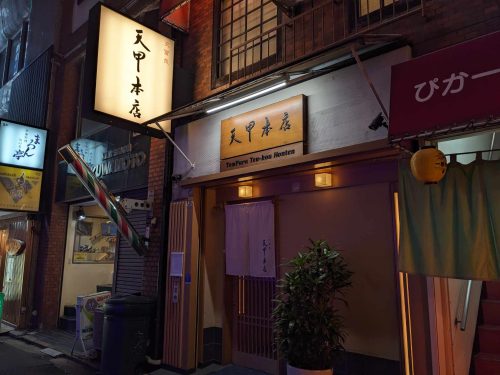
Starting the Course
The lady in the kimono took our drink orders, and when our beverages were served, the chefs immediately brought out our appetizers: a green salad topped with fried young anchovies, and a small sashimi platter featuring raw squid, sea urchin, and longtooth grouper.
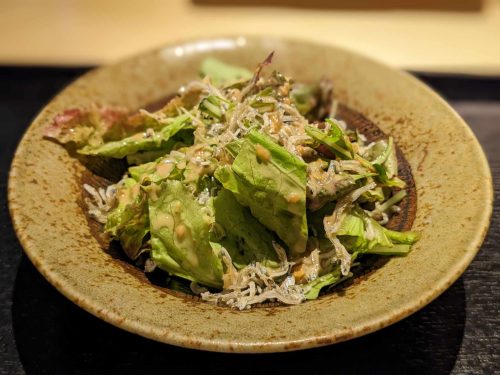

Only when we finished the two plates above did the tempura course begin in earnest, but first, the chefs put several dishes in front of us filled with various seasonings and sauces with which we would pair most of the items. From the top right going clockwise, we were provided with lemon salt, oroshi (grated daikon radish) in a pool of tempura sauce, curry powder, and salt for dipping our fried goodies, and every time a tempura dish was served, we were advised on which flavor to use. Of course, diners are not obligated to follow their recommendations, but the chefs know best so I trusted their advice, which I followed to a tee the whole night.
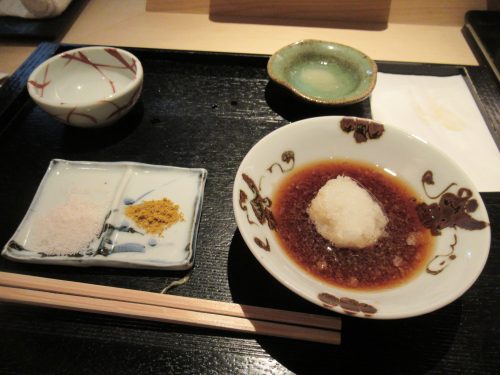
Spoiler alert: almost every piece of tempura that night would have salt as the recommended dip, but hey, that made it healthier and allowed us to savor the true flavor of the tempura. The first deep-fried dish served to us was two sets of prawn legs, which were brittle like chips and best eaten with salt. I first thought that it was odd to only serve the legs, but realized the rest of the prawns were still cooking and that they would taste different from the legs anyway. After finishing the legs, your standard prawn tempura hit the table; we were advised to eat the bodies with regular salt or lemon salt, but since I had two prawns, I decided to eat each prawn with a different flavor.
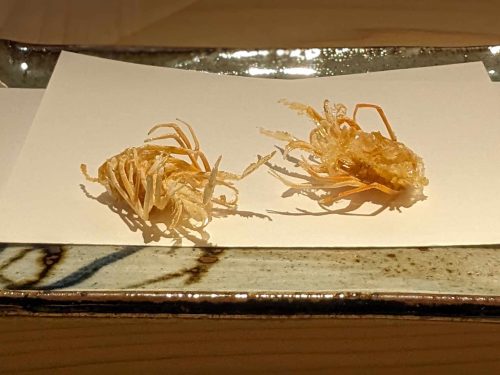

The prawns were followed by some more unique stuff, starting with some matsutake mushrooms, served along with a slice of sudachi. We were told to squeeze the sudachi to drench the matsutake in juice before dipping the fried fungi into plain salt to eat. The result was tart and so delicious that I wish I could’ve had sudachi with more foods.
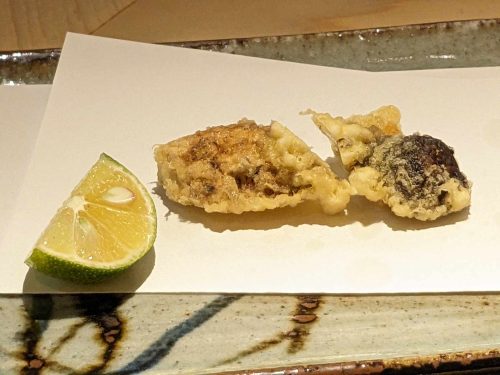
Following the matsutake was indubitably the strangest thing we would eat that night, but packed a punch so flavorful that the chef suggested we eat it as it was, without any extra flavors. It was salmon roe and perilla leaf wrapped in dried seaweed, fried to a crisp, and cut in half to reveal the gooey innards. I couldn’t have conjured up a creative name for this dish if I tried, and I struggle to even describe how I felt about the taste; it was just…salty. The next item to hit the table was a skewer of three ginkgo nuts, to be enjoyed with salt and nothing more. The somewhat bland flavor of the nuts was also a welcome switch in gears from the gastronomically busy “bur-roe-to” I had just ingested.
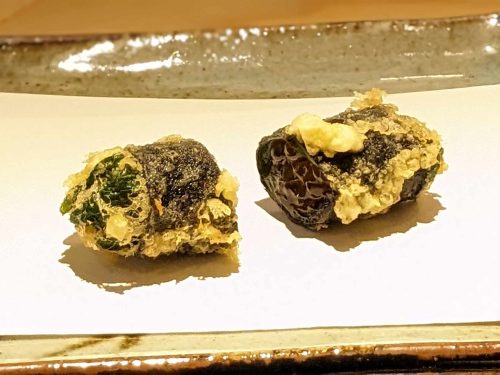
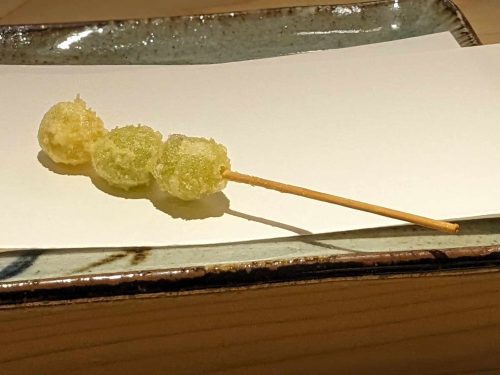
Moment of Joy: Trilingual Trifecta

As Tenkou gets a lot of international customers through its fame (it once earned two Michelin stars), the chefs were proficient enough in English to explain everything they were dishing out. However, they must have heard my guests speaking Mandarin because when these mushroom and scallop tempura came out, the chef introduced the ingredients by their Chinese names, which threw all of us for a loop. Being able to hear the names of all items in Japanese, English (you’d be surprised how many English fish species names are unfamiliar even to native speakers), and Chinese was actually a big help, as if I didn’t know the name of a certain food in one language, I could ask for the name in another language and instantly know what I was eating. Such resourceful customer service is befitting of a gourmet tempura joint, and I knew in that moment that international diners were in safe hands with these chefs at the helm.
Seafood Selection
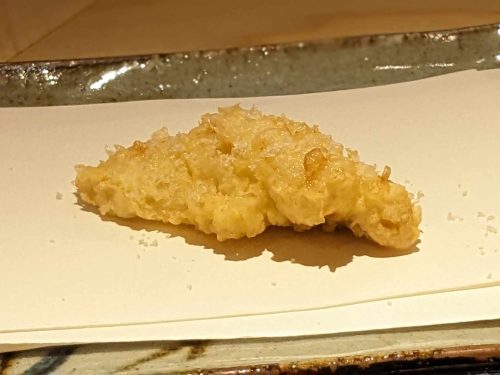
Moving on, a piece of blackthroat sea perch swam to our plates, with a special dash of truffle salt to accent the fish’s flavor. That was followed up with burdock root, a staple in Japanese cuisine but not so much in tempura; we were advised to eat it with salt. After that was the sea bream, yet another piece of fish, and the first thing of the night to warrant the oroshi and tempura sauce.

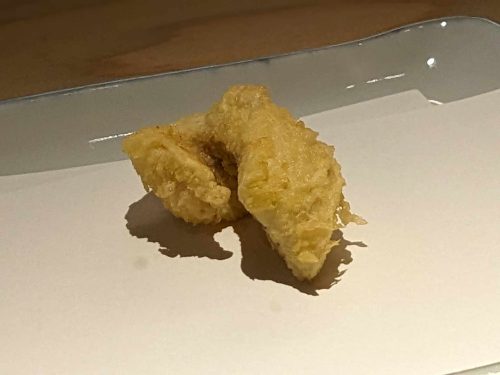
U.F.O.: Unidentifiable Fried Objects
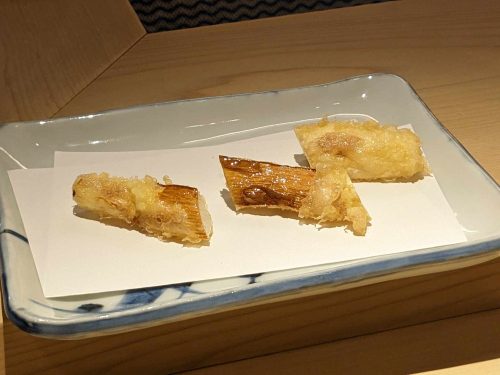
At this point during the meal, we were given tempura of a vegetable that the chef called “jiāobáisǔn (茭白筍),” which we didn’t recognize in any language, but I figured was some type of rare bamboo shoot. It wasn’t until much later that I tried looking up that Chinese name, which turned up the scientific name Zizania latifolia, as well as a plethora of English names such as “water bamboo,” “water rice,” “water oat,” and many more. It turns out that the Japanese name for this vegetable is makomo (真菰), and I’m not even sure if the chef said that. Anyhow, the chef did instruct us to eat this veggie with either salt or tempura sauce; with three pieces per diner, we had fun mixing and matching flavors.
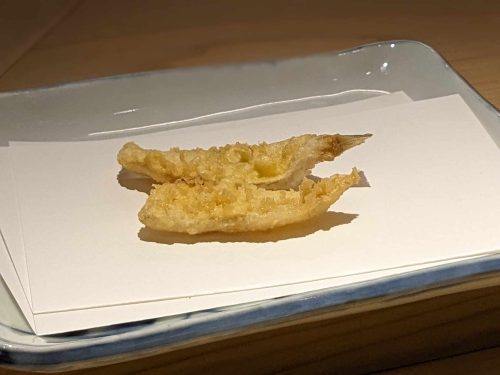
Next up was a fish named sillago in English, or kisu (鱚) in Japanese, a rather cute moniker for such a petite piscine portion. We were instructed to eat one with salt and the other with tempura sauce, both of which were scrumptious! From this point on, the tempura items got more and more recognizable, which meant we were not as reliant on the chef’s descriptions as we were before. The sillago were followed by the hen-of-the-woods mushroom, also known in Japanese as maitake (舞茸), which were to be consumed with salt, just like with the matsutake, but this time without sudachi juice.

The tempura that came after was a fish called tachiuo (太刀魚 – “longsword fish”) in Japanese, but called either cutlassfish or scabbardfish in English. Just like there’s a choice to how one calls it, there were also two recommended choices of dip: salt or tempura sauce. Since there was only one piece, I dipped each end in a different flavor and finished the fish in two bites. After that was the all-too-familiar lotus root tempura, whose recommended pairings were the same as those for the cutlassfish.
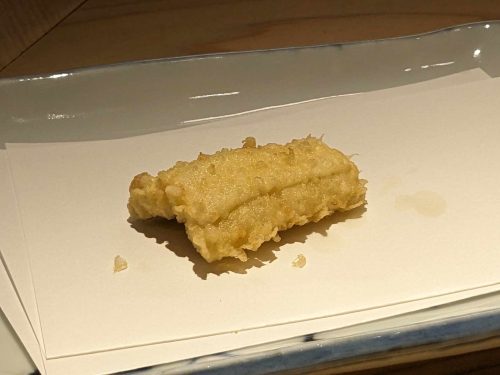

The last entry in a parade of tempura was the conger eel, appropriately saved for last considering its renown in Hiroshima Prefecture. It was served in four pieces due to its length, and was the only item to eaten with curry powder, much to my dismay. Every bite was as good as Hiroshima conger eel ought to be!
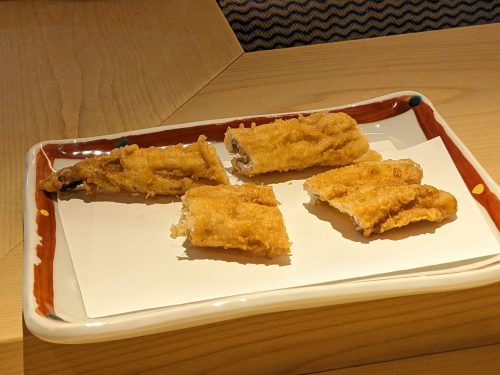
Finishing the Feast
To wrap up the dinner, the last thing before dessert was the rice bowl, and there were three choices available, all of which featured tempura. The first choice was a kaki-age donburi, which was a kaki-age (a fried disc of scattered veggies and seafood) on a bowl of rice, and can be found in many Japanese diners. Our second option was a more uncommon dish called a kaki-age hogushi, which was essentially the same as the first, except that the kaki-age was crumbled up and mixed into the bowl of rice. Finally, there was the choice of a kaki-age tencha, which was basically ochazuke (rice with toppings doused with green tea) but with a whole kaki-age on top, which was also a unique recipe. The former two came with a bowl of red miso soup, whereas the latter, already being a soup, simply included wasabi.
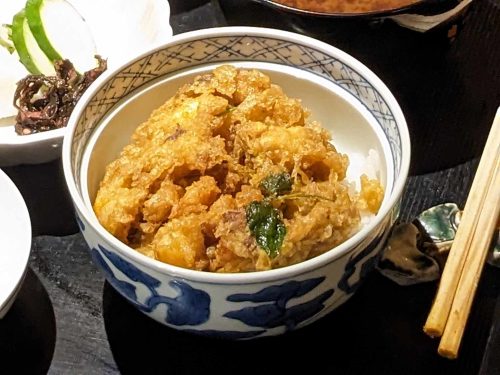
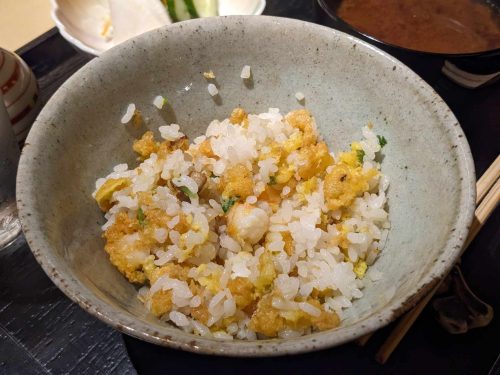
Because we were exactly a party of three, we decided to each order a different bowl in order to see what all the options looked like. The donburi is pictured in the top left, the hogushi the top right, and the tencha (my choice) below.

All the rice dishes came with a dish of Japanese pickles and a bottle of soy sauce to adjust the taste of the otherwise mild pickles. This last bit of carbs hit the spot and provided a fitting end to our course meal.

In spite of all of the above food, there was still room in our separate stomachs (別腹 – べつばら) for dessert, which Tenkou delivered in three forms: vanilla ice cream, fresh fruit, and mizuyokan (水羊羹), a gelatinous, rectangular dessert made from azuki beans. Once again, each of us got a different type of dessert so we could see and taste all the options, but honestly, only the mizuyokan was photogenic. The ice cream was just a single scoop in a simple dish and the fruit was literally three black grapes on a plate, but the mizuyokan and the utensil used to eat it actually looked quite presentable. Each dessert came with piping hot green tea in cups of various designs; mine had a poem of some sort painted on the inside before it was fired. While we munched on our post-meal sweets, the final bill, which included our drink orders (we ordered quite a bit of alcohol with our food) on top of the course, arrived at the counter for us to confirm. Once we finished our dessert and saw that everything checked out price-wise, we paid (expensive places like this take credit cards, thankfully), gathered our belongings, and left as they bowed and saw us off.
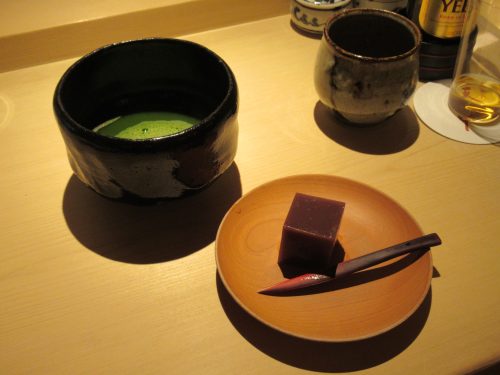

Pretty much every single item that night was photogenic, and stopping to photograph the food before eating every single time made for a busy meal of multitasking. However, the constant learning that happened during the photoshoot was entertaining, and both the presentation and taste of the tempura warrant at least one—if not two—Michelin stars, even if Tenkou no longer has the aforementioned stars. Stars or no stars, though, the flagship store is beloved by locals and constantly touted by travel guides and publications, cementing its reputation for providing the best tempura in town. International tourists—and just about anyone else for that matter—hankering for some deep-fried fine dining will for sure be satisfied by the beautiful, educational, filling, and multilingual experience that Tempura Tenkou’s flagship store has to offer in the heart of Hiroshima City.
Written by the Joy in Hiroshima Team
